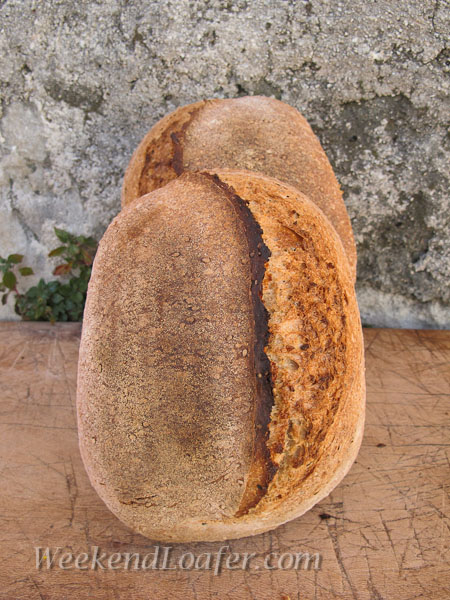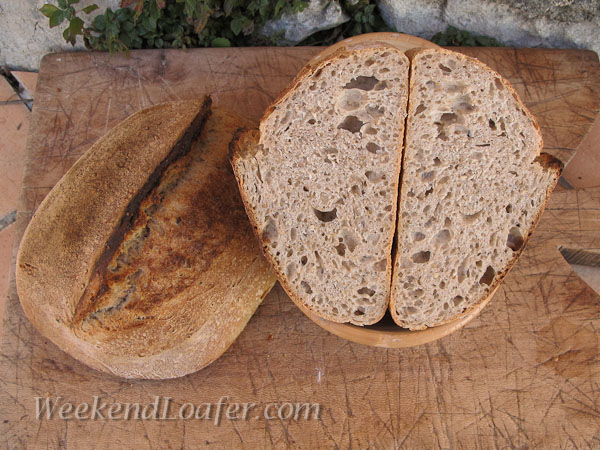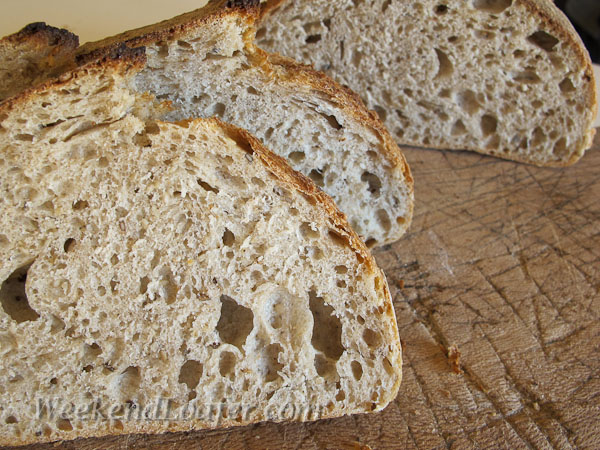
My first entry to Weekend Loafer in August 2011 was the quintessential French sourdough- Pain au Levain from Daniels Leaders’ Local Breads…and by coincidence I will end the year with Pain au Levain — but this time from Jeffrey Hamelman’s Bread: A Baker’s Book of Techniques and Recipes. As I have baked this recipe many times before with great success, I thought I might try and guild the lily by adding a little twist to the recipe. A search of my box of flours in the pantry produced a half bag of some bio spelt flour, some sesame seeds so I did some quick calculations … and off we went.
After the autolyse I added the levain and salt, but the dough was too stiff probably because the hydration was a little off for a Pain au Levain (must have been the thirsty spelt flour). So I incorporated a little extra water as I kneaded the dough in order to bring it to a workable soft consistency. The shaping and proofing went according to plan, but when I turned out shaped loaves and slashed them, they did not hold their shape and had a rather low profile. Nonetheless, I slid them onto the hot baking stone, into a steamy oven and they underwent their trial by fire. As there was nothing I could do at that point but cross my fingers and hope for a good oven spring, I went outside to sit in the warm late noon winter sun and take in the view of my valley.

The anticipation was too much to take, so I peeked into the oven — and a big smile came upon my face. My fears of finding flat pancakes evaporated. The loaves had sprung up and showed a great exterior color. But the proof was in the tasting! I have become a big fan of using spelt in my sourdough breads. The spelt imparts a rich subtitle nutty taste that is really hard to describe. And the combination of the sesame seeds and spelt is a truly winning combination. But the next time I make this great bread I think I’ll roast the seeds beforehand instead of soaking them for an even richer overall flavor.

Pain au Levain with whole spelt and sesame seeds
Loosely Adapted from Jeffrey Hamelman’s Bread: A Baker’s Book of Techniques and Recipes.
Desired dough temperature 76°
Makes 2 loaves
Levain Build:
- 28 g Stiff levain
- 130 g Bread flour (I used Type 65)
- 85 g Water
Ingredients:
- 539 g Bread flour(I used Type 65)
- 201 g Whole spelt flour (Grand épeautre)
- 28 g Medium Rye (I used Type 150)
- 505 g Water
- 224 g Stiff levain (do not use all of the above starter, weigh it out!!!)
- 17 g Gray sea salt
- 100 g Sesame seeds (optional) cover with 175g water and soak the night before, pat dry before adding to the dough
Bread method:
- The night before take your levain out of the refrigerator, weigh out the appropriate amount of starter and mash the levain with a whisk in a bowl with the water. Add the flours and stir with a spatula until it comes together. Turned out onto the work surface and knead to incorporate the flours. Place the Levain in a covered container and let it sit at room temperature (70°) for 12 hours. After you prepare the Levain place the sesame seeds in a bowl with the water to cover and tightly cover.
- Pour the water into a large mixing bowl or the bowl stand mixer. Combine flour, spelt flour, rye flour and water until all the ingredients are incorporated. Cover and let it rest for 20 minutes, while the flour hydrates and the gluten begins to develop. (I could not fit my Kitchen Aid Pro in my suitcase, so I mix by hand… I autolyse/rest for 20 minutes before adding the Levain, which really helps the gluten development)
- Kneading By hand: Turn the dough out onto your work surface. (I had to add a small amount water to achieve the desire consistency) I flatten the dough into a large rectangle; smear the Levain on top of the dough. With floured or oiled hands knead a few strokes to fully incorporate the starter, flatten out the dough again and evenly disperse the salt and continue kneading for 12 to 15 minutes. I use a combination of the French kneading technique (video) and this method if the dough is really wet (video) to start. For the first couple of minutes it will be a sticky mess on your work surface, but do not yield to the temptation of adding more flour. Stop occasionally and use your bench scraper to gather any stray dough off of your work surface and ceiling. Continue until you have a good gluten development. You should be able to gently stretch a piece of the dough into a thin membrane that you can almost see through without it tearing. Place the seeds on a towel to remove excess water. At this time add the soaked seeds. I add them at the end of mixing to prevent the sharp grains from ripping the gluten structure. Knead the seeds into the dough till evenly distributed. By machine: Add the salt and Levain and mix the medium speed until the dough cleans up the bowl and you reach a good gluten development. Add seeds on low speed the last minute or so.
- Transfer the dough to a lightly oiled container. Cover and let it ferment at room temperature for 2 ½ hours (76°). Fold the dough twice at 50 minute intervals. If you would like see the folding process and get a good overall picture of the bread making process for the home baker, I highly recommend you check out Mark’s videos at the Back Home Bakery
- Divide into two equal pieces and lightly pre-shape into a boule or log shape. Lightly flour the dough, cover and let rest for 10-15 minutes. Shape each piece of dough into a batard or an oval or boule and place seam side up on a floured couche or into floured bannetons. Cover with a plastic bag or plastic wrap and proof at room temperature for 2-2 1/2 hours. (76°) When you press your floured finger into the dough, the indentation will spring back slowly.
- About one hour before baking, preheat the oven to 500°with baking stone and a tray in the bottom of the oven for steam. I like to add one cup of water or a hand full of ice cubes to the bottom tray a few minutes before putting the loaves in the oven to produce a moist environment for the baking of the proofed loaves.
- Gently turn the proofed loaves onto parchment paper or your floured peel. Score the loaves. Slide the loaves onto the baking stone, turn down the oven to 460° and continue to bake for 40-45 minutes. (I turn the oven down and then after 20 minutes, rotate them to get an even distribution of the heat and continue to bake until I have good color and when you tap the bottom of the loaf you hear a thud). I like to give the loaves a bold bake to help cook the interior loaf.
- Let cool on a wire rack before digging in.

This post is being sent to WildYeast at YeastSpotting





